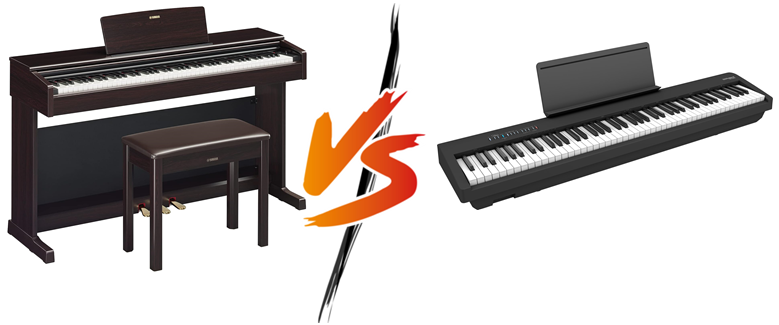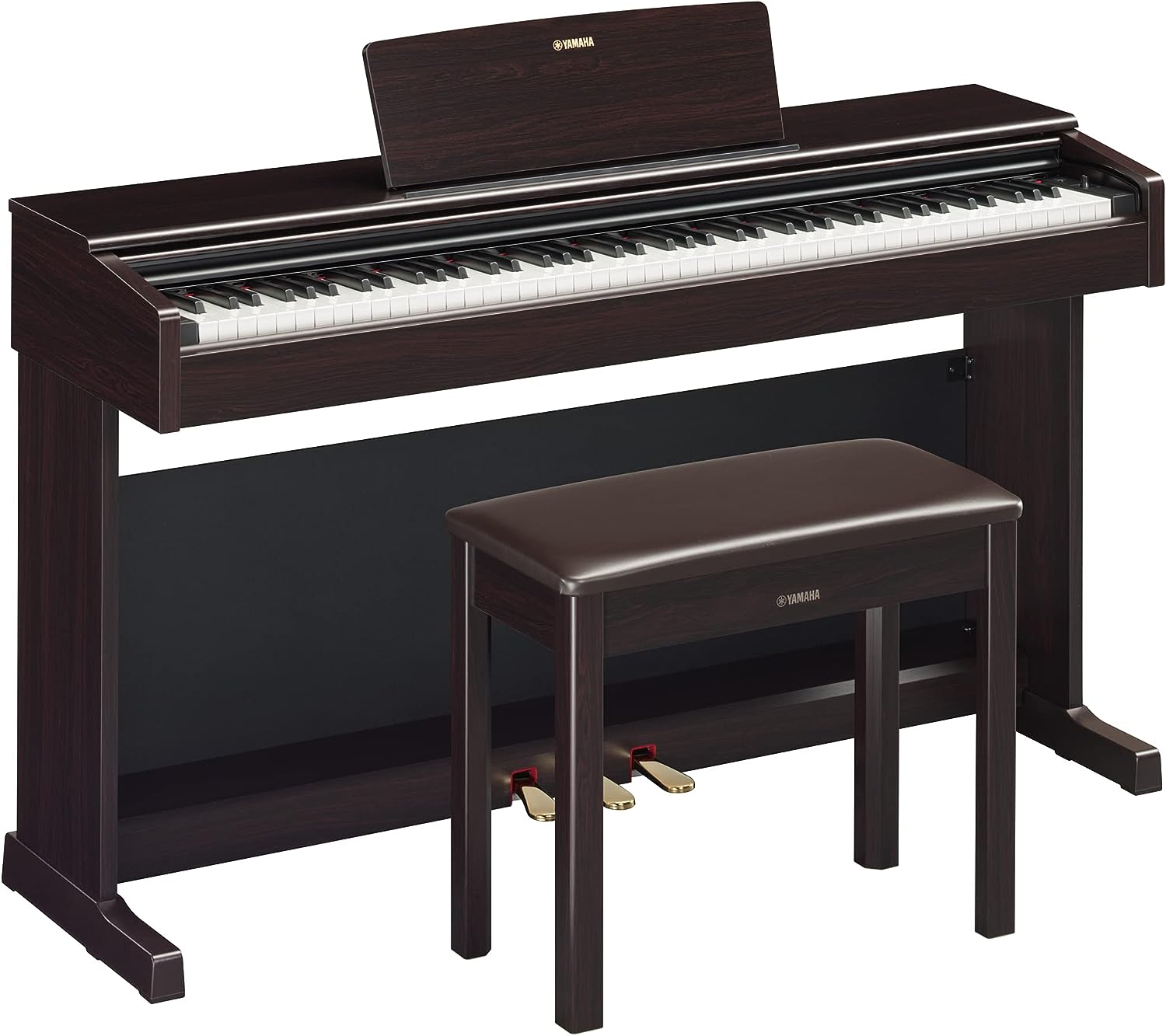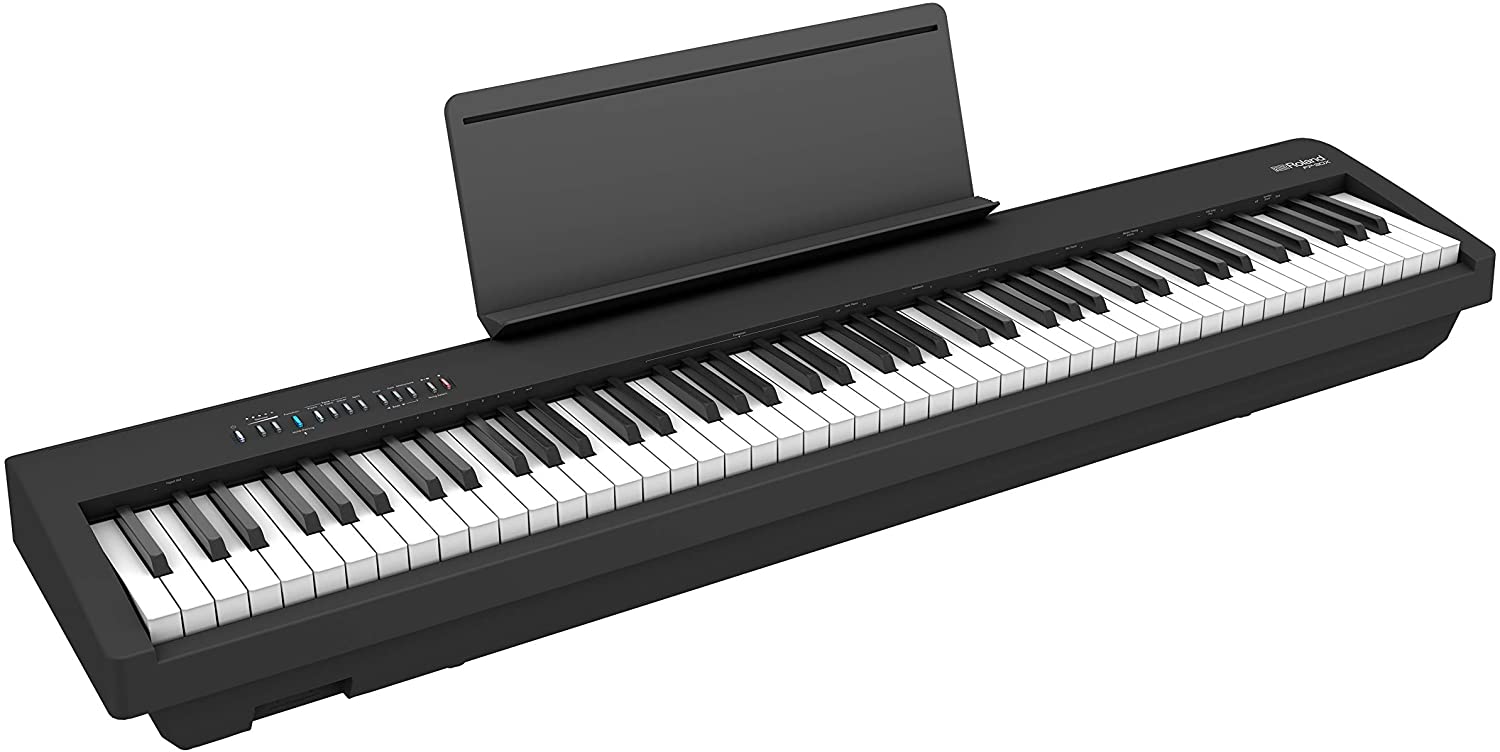Digital pianos have come a long way in terms of replicating the feel, sound, and experience of acoustic pianos. Among the most prominent names in this industry are Yamaha and Roland, both renowned for delivering high-quality instruments that cater to a wide range of users.

In this review, we’ll pit the Yamaha YDP-145 vs Roland FP-30X—two popular mid-range digital pianos. While they are designed for slightly different purposes (the YDP-145 is more of a home-styled upright digital piano, whereas the FP-30X is a portable model), you’re not the only one that is likely to be weighing these options based on similar criteria like sound quality, touch response, features, and overall value for money. Let’s dive deep into the details and compare them across multiple important categories.
Yamaha YDP-145 vs Roland FP-30X Comparison Chart
Here’s a comparison table between the Yamaha YDP-145 and Roland FP-30X, highlighting their key specifications:
If you click the links below, under the product images you will be redirected to Amazon.com. In case you then decide to buy anything, Amazon.com will pay me a commission. This doesn’t affect the honesty of this review in any way though.
| Feature | Yamaha YDP-145 | Roland FP-30X |
|---|---|---|
 |  | |
| Check best price on Amazon | Check best price on Amazon | |
| Design Type | Upright Digital Piano (Cabinet Style) | Portable Digital Piano |
| Dimensions (W x H x D) | 136 x 81.5 x 42 cm | 134 x 15 x 26 cm |
| Weight | 38 kg (84 lbs) | 14.8 kg (32.6 lbs) |
| Keyboard Action | Graded Hammer Standard (GHS) | PHA-4 Standard with Escapement |
| Key Material | Plastic keys, matte finish on black keys | “Ivory Feel” keys (textured) |
| Polyphony | 192 notes | 256 notes |
| Piano Sound Engine | Yamaha CFX Grand Piano Sampling | SuperNATURAL Sound Engine |
| Sound Technology | Virtual Resonance Modeling (VRM) | SuperNATURAL with dynamic modeling |
| Number of Sounds | 10 voices | 56 voices |
| Speakers | 2 x 12 cm, 8W each | 2 x 11W each |
| Headphone Output | Dual headphone jacks | Dual headphone jacks |
| Recording | 2-track MIDI recorder | MIDI and Audio recording (WAV) |
| Bluetooth Connectivity | No | Yes (MIDI and Audio) |
| USB Connectivity | USB to Host | USB to Host and USB to Device |
| Pedals | 3 pedals (sustain, sostenuto, soft) | 1 sustain pedal (optional 3-pedal unit) |
| Modes | Dual, Duo | Dual, Split |
| App Integration | Smart Pianist App | Piano Every Day App |
| Amplification Power | 2 x 8W | 2 x 11W |
| Included Accessories | Music stand, 3-pedal unit | Music stand, sustain pedal |
| Finish Options | Black, White, Rosewood | Black, White |
| Price Range | $1,000 – $1,200 | $700 – $900 |
| My individual reviews | Yamaha YDP-145 review | Roland FP-30X review |
Key Differences:
- Keyboard Action: The Roland FP-30X’s PHA-4 Standard action with escapement is more advanced compared to Yamaha’s GHS action.
- Polyphony: The Roland FP-30X has a significantly higher polyphony (256 vs. 192 notes).
- Portability: The FP-30X is much lighter and compact, making it more portable.
- Connectivity: The FP-30X offers Bluetooth connectivity (both MIDI and audio), which the YDP-145 lacks.
- Pedals: The YDP-145 has a built-in 3-pedal system, while the FP-30X comes with a single pedal (with an optional 3-pedal unit).
- Sound Customization: Roland’s SuperNATURAL sound engine with 56 voices provides more versatility than Yamaha’s 10 voices.
The Roland FP-30X is generally more feature-rich and portable, while the Yamaha YDP-145 offers a more traditional upright design with a classic piano experience suitable for home use.
Design and Build Quality
Yamaha YDP-145
The Yamaha YDP-145 is part of Yamaha’s popular Arius series, which is known for its classic upright digital piano designs. The piano features a wooden cabinet that resembles a traditional acoustic upright piano, making it an ideal fit for home environments where aesthetics matter.
- Dimensions: The YDP-145 measures around 53.5 inches (136 cm) wide, 32 inches (81.5 cm) tall, and 16.5 inches (42 cm) deep. It weighs about 38 kg (84 lbs), which, while substantial, is standard for a cabinet-style piano.
- Appearance: It offers a polished, minimalist design available in multiple finishes (black, white, and rosewood), which can blend seamlessly into living rooms or studios.
- Pedals: The piano comes with three pedals (sustain, sostenuto, and soft), providing the full acoustic piano experience.
- Build Quality: As with most Yamaha products, the build quality is excellent. The wooden cabinet is sturdy, the finish is smooth, and the overall construction feels premium. However, given its size and weight, it’s not ideal for portability and is more suited for a fixed installation in the home.
Roland FP-30X
The Roland FP-30X, on the other hand, is a portable model, offering a lightweight and more minimalist design than the YDP-145. It is part of Roland’s FP series, which is known for compact, portable digital pianos with high-end features.
- Dimensions: It’s significantly smaller than the YDP-145, measuring about 52.8 inches (134 cm) wide, 5.9 inches (15 cm) tall, and 10.2 inches (26 cm) deep. It weighs only 14.8 kg (32.6 lbs).
- Appearance: While the FP-30X is much more compact, its design is sleek and modern, with simple lines and a matte finish available in black or white. It’s designed to be used on a stand or even on a table, depending on your needs.
- Pedals: Unlike the YDP-145, the FP-30X comes with a single pedal (a basic sustain pedal), but you can purchase an optional pedalboard that adds a more comprehensive set of three pedals.
- Build Quality: The FP-30X is constructed from durable plastic, which reduces its weight but makes it less robust than the YDP-145. That said, the overall feel is solid for a portable piano, and the compact size makes it ideal for gigging musicians or those with limited space.
Verdict:
If you’re looking for a home piano with a more traditional look, the Yamaha YDP-145 wins in terms of design and build. However, for portability, the Roland FP-30X is the clear winner thanks to its compact size and lightweight design.
Keyboard and Action
Yamaha YDP-145
The Yamaha YDP-145 comes equipped with the Graded Hammer Standard (GHS) action, which is a staple of Yamaha’s entry- to mid-range digital pianos. The GHS action is weighted to simulate the feel of an acoustic piano, with heavier keys in the lower register and lighter keys in the higher register.
- Key Feel: The GHS action is generally well-regarded for its smoothness and reliability. It’s not quite as refined as Yamaha’s higher-end GH3 or NWX actions, but for most players (especially beginners and intermediate pianists), it provides a realistic and enjoyable playing experience.
- Key Material: The keys are made of plastic with a matte finish on the black keys, which helps reduce slippage during long playing sessions. However, they lack the synthetic ivory or ebony feel that’s found on higher-end models.
- Touch Sensitivity: The YDP-145 offers three levels of touch sensitivity (soft, medium, hard) to suit different playing styles. This allows you to adjust the touch response according to your personal preference.
Roland FP-30X
The FP-30X uses Roland’s PHA-4 Standard action, which is a more advanced keybed compared to the GHS action on the YDP-145.
- Key Feel: The PHA-4 Standard action is well-known for its responsiveness and dynamic range. The action features Roland’s “Ivory Feel” keys, which provide a more textured surface for both the white and black keys, mimicking the touch of real ivory and ebony. This texture improves grip and comfort, especially during longer playing sessions.
- Escapement: A standout feature of the PHA-4 action is its escapement mechanism, which is designed to simulate the “click” you feel on an acoustic grand piano when you press the keys lightly. This gives a more authentic piano-playing experience, especially for advanced pianists.
- Touch Sensitivity: Like the YDP-145, the FP-30X also offers multiple levels of touch sensitivity, allowing users to customize the response to their liking.
Verdict:
In terms of keyboard action, the Roland FP-30X pulls ahead with its PHA-4 Standard action, offering better touch realism, superior material quality (Ivory Feel keys), and an escapement feature that brings it closer to the feel of an acoustic piano. For more advanced players, the FP-30X’s keyboard is more likely to satisfy.
Sound Quality
Yamaha YDP-145
The Yamaha YDP-145 features Yamaha’s CFX Grand Piano Sampling, a key selling point for this model. This sound engine is based on the sampling of Yamaha’s renowned 9-foot CFX concert grand piano.
- Piano Sound: The CFX grand piano sound is rich, detailed, and expressive, making it suitable for a wide range of genres. It’s especially appreciated for its brilliance in the treble and power in the bass. The realism of the tone is enhanced by Yamaha’s proprietary Virtual Resonance Modeling (VRM) technology, which replicates the way sound resonates inside a grand piano.
- Polyphony: The YDP-145 comes with 192-note polyphony, which is sufficient for most complex pieces and allows for sustained notes, layered sounds, and detailed pedaling without notes cutting off prematurely.
- Additional Voices: While the CFX piano sound is the highlight, the YDP-145 also offers 10 additional voices, including electric pianos, organs, strings, and harpsichord. These extra sounds are useful for versatility but are somewhat limited in number compared to other digital pianos.
Roland FP-30X
The Roland FP-30X is equipped with Roland’s SuperNATURAL Piano Sound Engine, which has been praised for its ability to replicate the nuances of acoustic pianos with stunning accuracy.
- Piano Sound: The SuperNATURAL sound engine produces a beautifully warm, rich tone with smooth transitions between different dynamic levels. It excels in realism, particularly in how it captures the behavior of an acoustic piano, from subtle key presses to full, rich chords.
- Polyphony: The FP-30X offers 256-note polyphony, significantly higher than the YDP-145. This ensures that even in the most demanding pieces, there’s no risk of notes being cut off.
- Additional Voices: The FP-30X has 56 additional tones, including electric pianos, strings, organs, pads, and synths. This broader range of voices makes the FP-30X more versatile, especially for those who like to experiment with different genres or need variety for recording.
Verdict:
Both pianos deliver exceptional sound quality, but the Roland FP-30X edges ahead due to its superior polyphony and wider range of voices. The SuperNATURAL sound engine is more dynamic and expressive, making the FP-30X a better choice for more experienced players or those who want greater versatility.
Speakers and Amplification
Yamaha YDP-145
The Yamaha YDP-145 comes equipped with a built-in speaker system that includes two 8-watt amplifiers driving two 12 cm speakers.
- Speaker Quality: The speakers deliver clear and balanced sound, though they may lack the depth and power that more advanced models offer. For home use in a small to medium-sized room, the speakers are more than sufficient.
- Bass Response: The YDP-145 does a good job with bass frequencies, thanks to its large cabinet, which helps project sound more effectively.
Roland FP-30X
The Roland FP-30X also comes with two built-in speakers, but it offers slightly more powerful amplifiers (11 watts per channel).
- Speaker Quality: The FP-30X’s speakers are punchy and clear, delivering a more immersive sound experience than the YDP-145, especially in the mid and high frequencies. However, due to its compact form, it doesn’t quite have the same natural bass response as a cabinet-style piano.
- Headphone Experience: One of the standout features of the FP-30X is Roland’s 3D Ambience for headphone use. This creates a more spatial and immersive sound experience when playing with headphones, something that the YDP-145 lacks.
Verdict:
The speaker systems on both models are solid for their categories, but the FP-30X’s more powerful amplification and superior headphone experience make it a better choice for those who frequently play with headphones or in louder environments.
Features and Functions
Yamaha YDP-145
- Recording: The YDP-145 offers basic recording functionality with the ability to record and playback your performances using the built-in 2-track MIDI recorder.
- Dual Mode: Allows you to layer two sounds together, such as piano and strings, for a richer, more complex tone.
- Duo Mode: This function splits the keyboard into two identical zones, making it perfect for teaching, as both teacher and student can play the same range of notes.
- Metronome: A built-in metronome is available for practicing, but it’s a standard feature across most digital pianos.
- Smart Pianist App: Yamaha offers the Smart Pianist app, which enhances the functionality of the piano by providing control over settings, access to a large music library, and even chord recognition from audio files.
Roland FP-30X
- Recording: The FP-30X includes both MIDI and audio recording capabilities. You can record your performances directly as high-quality WAV files, making it a more versatile tool for musicians who want to record and share their performances easily.
- Dual/Split Mode: The FP-30X offers both layering (Dual mode) and split functionality, allowing you to assign different sounds to different parts of the keyboard.
- Built-in Rhythms: The FP-30X also includes built-in drum patterns and rhythms, which can add a new dimension to your practice or performances.
- Bluetooth Connectivity: One of the standout features of the FP-30X is its Bluetooth audio and MIDI connectivity. This allows you to wirelessly stream music from your phone or tablet, or use it with MIDI apps for practice and recording.
- Piano Every Day App: Roland’s Piano Every Day app allows for practice tracking, lesson planning, and access to Sheet Music Direct, making it a powerful companion for improving your piano skills.
Verdict:
The FP-30X offers more features and greater versatility, particularly with its Bluetooth connectivity and audio recording capabilities. It’s a better choice for musicians who want modern features and a piano that can integrate easily with apps and other devices.
Connectivity
Yamaha YDP-145
- USB to Host: The YDP-145 includes a USB-to-Host port for connecting to computers or smart devices. It supports basic MIDI functionality but lacks more advanced connectivity options.
- Headphone Jacks: Dual headphone jacks are available, which is great for private practice or for playing along with a teacher.
- No Bluetooth: The YDP-145 lacks Bluetooth connectivity, which is a noticeable omission at this price point, especially compared to the FP-30X.
Roland FP-30X
- USB to Host: The FP-30X also offers USB-to-Host for MIDI connections and can connect to computers or mobile devices for using digital audio workstations (DAWs) or learning apps.
- Bluetooth: A major advantage is the Bluetooth MIDI and audio functionality, allowing for wireless connectivity with smart devices. This opens up a wide range of possibilities, including practicing with online lessons or streaming music through the piano’s speakers.
- Headphone Jacks: Dual headphone jacks are included as well, making it perfect for teacher-student settings.
Verdict:
The FP-30X takes the lead here with its Bluetooth connectivity, offering far more convenience and integration with modern devices. If connectivity is important for you, the FP-30X is the obvious choice.
Portability
Yamaha YDP-145
The Yamaha YDP-145 is a stationary piano, designed primarily for home use. Its size and weight make it cumbersome to move, and it’s not intended for gigging musicians or those who need a portable solution. However, if you want a piano that will stay in one place and resemble a traditional acoustic upright, the YDP-145 is a great fit.
Roland FP-30X
In contrast, the Roland FP-30X is lightweight and portable, making it ideal for musicians on the go. Whether you need to move it around your house, take it to gigs, or transport it to lessons, the FP-30X is designed with mobility in mind.
Verdict:
If portability is a key factor, the FP-30X wins hands down. Its compact size and lightweight design make it much easier to move around compared to the more stationary YDP-145.
Value for Money
Yamaha YDP-145
The Yamaha YDP-145 is positioned as an entry-level to mid-range home piano. It offers great value for those seeking a traditional upright digital piano experience, especially for beginners or families looking for a reliable instrument. However, compared to the FP-30X, it lacks some modern features like Bluetooth connectivity and a wider range of sounds.
Roland FP-30X
The Roland FP-30X offers excellent value for money, especially considering its portability, superior keyboard action, higher polyphony, and Bluetooth connectivity. It appeals not only to beginners but also to intermediate and even advanced players who want a versatile, portable piano with professional-level features.
Verdict:
Both pianos are priced competitively for their features, but the FP-30X offers more value for those who want a broader range of functions and more advanced technology. If you’re looking for a piano with better portability, superior key action, and modern features, the FP-30X is the better investment.
Which One Should You Buy?
Ultimately, the choice between the Yamaha YDP-145 and the Roland FP-30X comes down to your individual needs.
- Choose the Yamaha YDP-145 if: You want a traditional upright digital piano for home use, appreciate the look and feel of an acoustic piano, and are mainly focused on piano playing without the need for extensive modern features. It’s a great choice for beginners or those who prefer Yamaha’s signature piano sound.
- Choose the Roland FP-30X if: You’re looking for a versatile, portable piano with a superior key action, more polyphony, a wider range of voices, and modern features like Bluetooth connectivity. It’s ideal for intermediate players, gigging musicians, or anyone who values portability and wants a piano that can integrate easily with technology.
In conclusion, while both pianos offer great features for their price points, the Roland FP-30X stands out for its versatility and advanced features, making it the better all-round option for most players.
